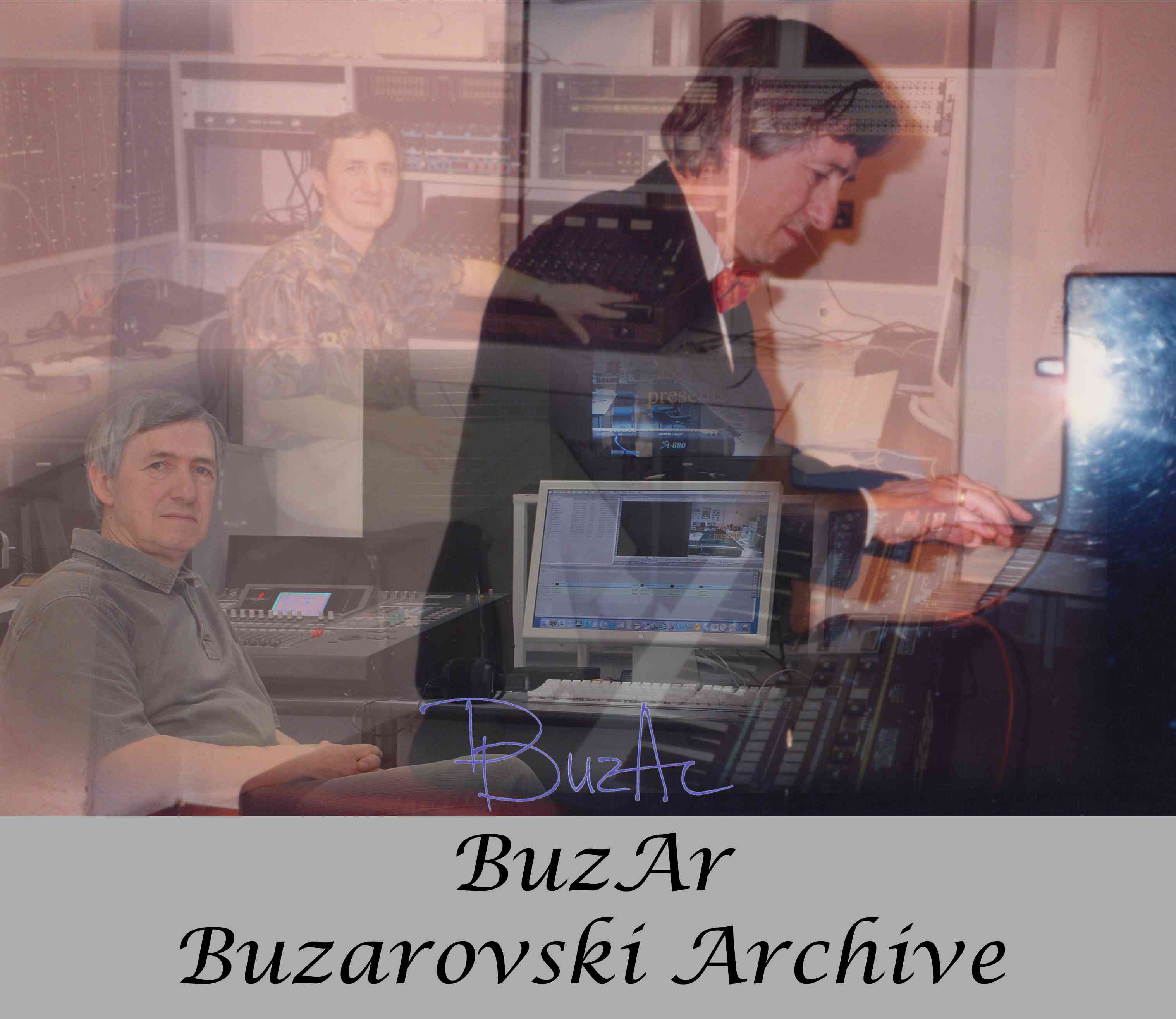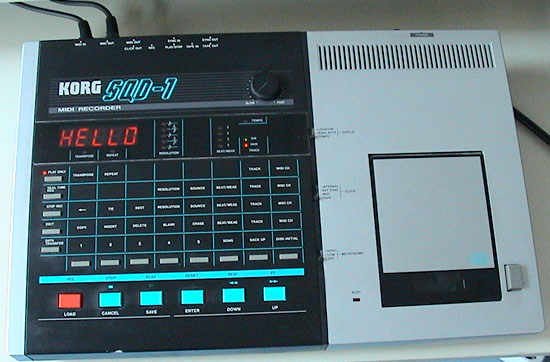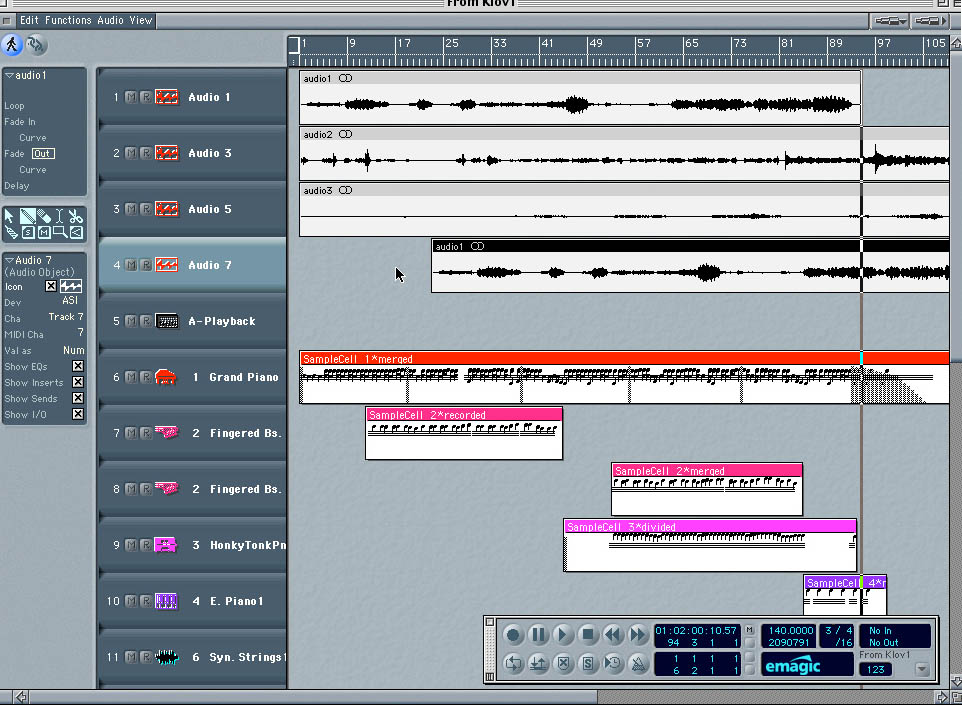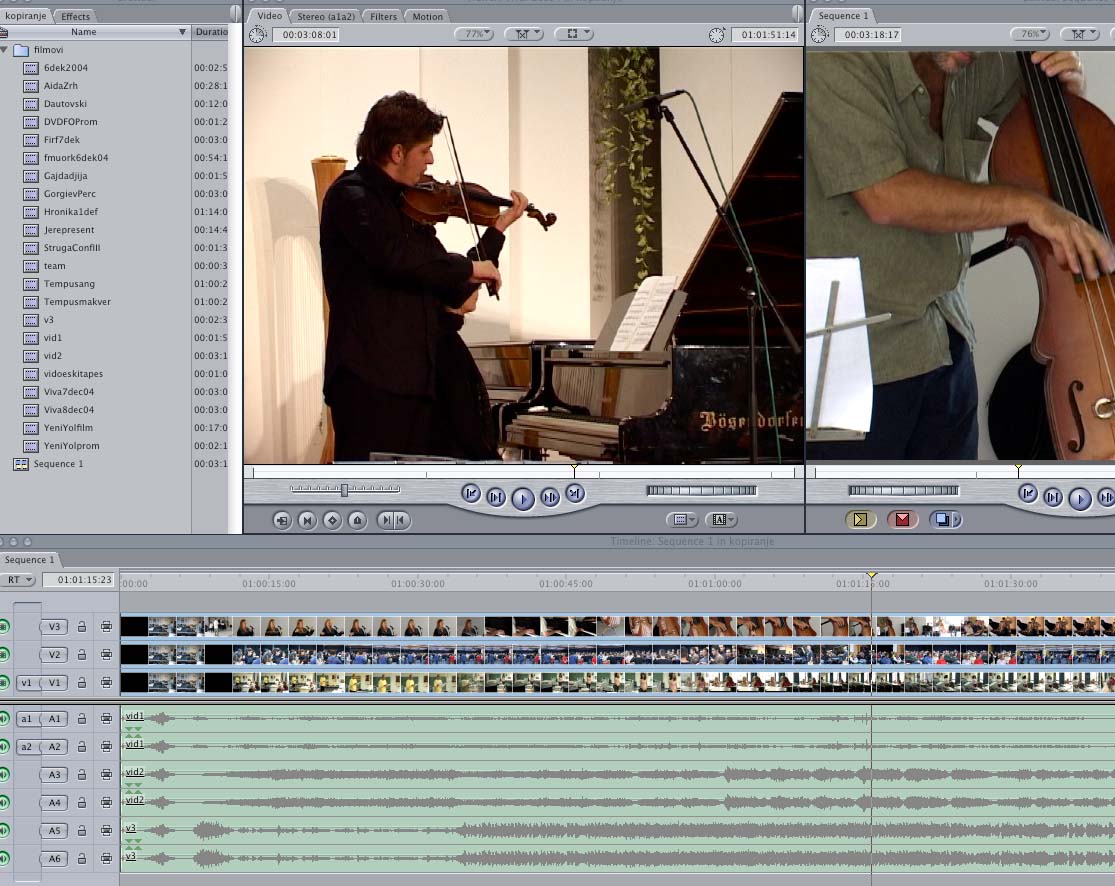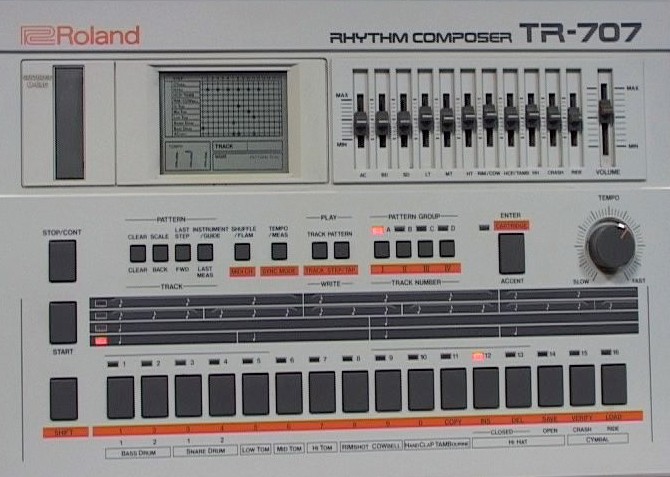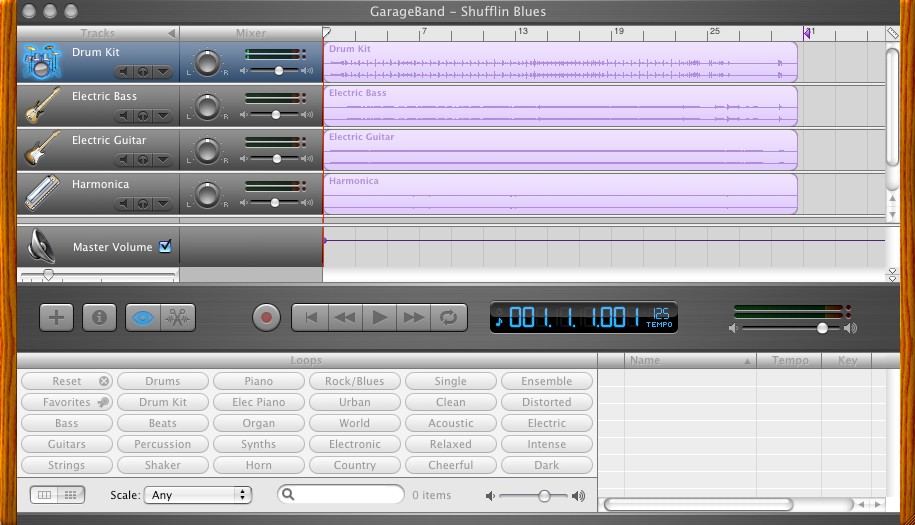| Dimitrije
Buzarovski Teaching Music Composition in the 21st Century: The Kingdom of Loops* |
|
– teaching
creativity – selecting among
different genres (contemporary, classical, jazz,
rock, pop etc.) – selecting
between classical tonal tradition and other
contemporary approaches. We
will leave all these dilemmas for another
occasion, and concentrate only on
the
influence of the specific phenomenon which
appeared at the beginning of the 1990s and became
typical for music creation in the new century – the loops. There
were two parallel lines which contributed to the
appearance of loops – sequences and
samples. The
sequences were introduced
to music hardware and software through the MIDI protocol in the
mid 80s. The basic music principle (and of
course not only in music) of
repetition
was implemented in the philosophy of the new
computer software, and soon, at the end of the
80s, MIDI sequencers where graphically developed
from matrix to score
presentations.
The MIDI protocol is still the basis of score
processors, in fact it is their essential and an
integrate part, and despite of the fact that
MIDI technology is already
very
outdated, i.e. too slow for the capacity of the
computer hardware, the world still operates with
the old rules fixed in the mid 80s. Its
interchange ability and general use enabled it to
survive much longer than the use of any other
protocol.
At
the beginning of the 90s, the first commercial
HD audio recording hardware
and
software (such as DigiDesign Pro Tools)
integrated the sequencing principles.
Based
on
the MIDI sequencing principle, the recording
process was built around audio sequencer, again
presented through the timeline of the recorded
music piece.
It
was already predictable that at the next stage,
(when the capacity of the
hardware
will be able to handle video), the sequencing
principle will be extended to the video area.
Today, all video recording software uses
sequencing with separate or
integrated
audio sequencers. Furthermore, most of the audio
recording software, in addition to
having audio and MIDI sequences, also have the
capacity to drive video
sequences.
Once
the sequencing principle was established, the
loops appeared. They were
treated
either as an indefinite repetition of a
sequence, or a part of a sequence (a sequence within a
sequence). In fact, there is almost no
difference between a sequence and a loop, as sequence
could be defined as a loop which appears once or
several times, while the concept of a
loop always includes at least one repetition.
Today, we are inclined to think
of a
sequence almost as something identical to the
music piece, forgetting that the basic idea behind
sequencing was to integrate several sequences
into a piece. Thus, the loops
are
something smaller than a sequence. The
first MIDI sequencers were used to drive sounds
from different sources – analogue or
digital. Digital sound sources were based on
another important principle – sampling.
Audio
sampling, which is in fact the conversion of the
analogue into a digital
signal,
had to deal with the problem of loops. In order
to build indefinite sound sustainability
without clicking between the repetitions of the
original short sample, once
again,
the loops were introduced. The limited capacity
of the commercial music hardware at the end of
the 80s and the beginning of the 90s could not
compute larger algorhythms,
not
to mention the building of an instrument, which
needed a matrix of overlayers of
samples
in differenet registers, techniques of
performance etc. The
first samples used in the new audio digital
technology were mainly the
recordings
of acoustic instruments, thus helping the
synthesizers to produce bigger variety of
sounds. Very soon, the expansion of the capacity
of the hardware brought
about
the first longer samples, i.e. the samples with
longer duration, which consisted of the combination
of more sounds (such as tympani or cymbal
tremollo). On
the other hand, the rhythm machines from the 80s
had already employied a combination of the MIDI
sequencing and loops with prerecorded samples of
percussion. At that moment it was very easy to
predict where technology was heading.
The
first concerns were raised from the copyright
societies, as it was obvious that
a
significant parts of the compositions could be
built by the use of the loops. The main question was
whether the rights should be partly distributed
to the factory which
prerecorded
the patterns and samples. The
further development of the digital audio
technology conritubuted to the
greater
expansion of the variety of loops, which
included more and more different sounds, and
later the possibility of transposing or changing
the duration of the loops from
real
sounds (transposition and tempo changes were
available at the very beginning of the use of MIDI
instruments). In
the mid 90s, I was often approached by the users
of this technology who have
very
limited, or in some cases no music education,
but who were creating music by combining
different loops of prerecorded sounds. At that
moment, it was perfectly clear
that
this was a challenge for the traditional way of
creating, and consequently teaching music. In the foundation of this creation
lay the «collage» technique,
which was not unknown and was
particularly developed with the musique
concrète in the 50s. The concept was
entirely the same only the founders of the genre
Pierre Schaeffer and Pierre
Henry
did not have the advantage of DSP editing or
transformation of sounds. Meanwhile,
the kingdom of loops grew with accelerating
speed. With it grew the
number
of its users, especially in the area where it
started - rhythm (machines). This resulted in the
creation of an entirely new music practice of
the late 20th and early 21st
century
– the DJ. The
D(isk) J(ockey)s were the first to grasp the new
technology in structuring a
full
event. Their main task
(music for dancing) brings the rhythm in the
foreground – and loops originate
from rhythm. «Dancing is a rhythm» –
and the loops offered a lot of
rhythm
which could be controlled. Using loops as a
basis enables unlimited prolongation of dancing, thus
surpassing the problem of the duration of songs.
Although at the
beginning
DJs were not interested in fixing their work in
sound carriers, as the main purpose was the
live event, we can already find CDs with DJ
music. The
use of loops in some of the genres dominating
the last decade of globalized
music,
such as techno, rap, hip hop etc., was probably
an interaction. Loops were particularly
useful for the permanent repetitions in these
genres, very easy to create, and
in
general they form a very high percentage of the
music material (even in some techno pieces, all of
it). The adding principle of building the
compositions in these genres (the
piece
usually starts with a rhythmic pattern with a
percussion or bass section, and then new elements
(patterns, loops) are added one by one, or
subsequently), contributed to the
use
of loops. Loops and the structure of the music
pieces of these genres interacted in their
development, thus further widening the
kingdom
of loops. And
here we are today, with loops everywhere, from
electronic music to all kinds
of
rock, pop, techno, hip hop, ambient, DJ music
etc. The software
industry closely
followed
and responded to this trend. The latest packages
with the Macintosh operative systems (OS X –
panther, tiger etc.) include a free software for
audio and MIDI recording
– Garage
Band.
Although
with a much lower performance compared to the
similar professional
packages
and mainly targeting the wide audience of music
fans, this software is in fact at the level of the
professional HD audio and midi recording from
the beginning of the 90s.
It
also reflects our dreams of getting rid of all
additional hardware (cards, interfaces etc.) which we needed
in the 90s. It was evident that the rise of
hardware computing capacity
would
result in software solutions. The fascinating
side of this development is that today, we could even
process video without additional hardware (Final
Cut for instance). Video needs much more
computing power, communication capacity and
storage space, than the
audio
itself. Garage
Band comes with a set of hundreds of loops even
categorized in different
genres
(for instance Rock/Blues). The availability of
loops is further extened by Internet exchange. There
are thousands of loops which can be imported
from the Internet. The integrated MIDI
instruments in the system software (Quick Time
instruments) enable
interventions
inside the loops, including the change of tempo
or transposition. Music pieces could be
created faster than their full length
(duration), something unthinkable in the past. The
integrated mikes in the latest models of Mac
computers, add to the karaoke
fun
of creating music. We
should not underestimate the value of the
thousands of pieces created by
amateurs
with these new tools. Some of the compositions I
have heard, made by enthusiasts,
have a much higher level of creation than a lot
of electronic music pieces
from
the 60s to the 80s. In some cases, electronic
music from the past looks naïve when compared to the
achievements of the loops collage. We
can expect that this development will be
accelerated to the extent where we
will
question the need of new recordings, as there
will be enough recorded material to build any kind
of music composition. If in the 90s music fans
who did not have music
education
could create music by buying synthesizers,
rhythm machines and other modules, nowadays,
everyone has access to music tools by bying Mac
computers. How
does this relate to teaching music composition? In
a certain way music composition has always taken
advantage of collage for
building
the overall structure of the piece. Considering
the philosophy of computer editing and its
three crucial commands copy/cut/paste
there
are more than obvious
similiarities.
The first score processors equally introduced
the principle of loops by copying, cutting
and pasting the repetitions of the same thematic
materials, and even
whole
sections. New horizons were opened up for the
faster creation and assembling of the music piece. Consequently,
we can not say that the loops principle is not
already integrated in
the
composition courses, and students of
composition, especially those who are more inclined to
follow the development of technology, are fully
aware of these advantages.
The
question is how professional composers will
compete with the army of enthusiasts and amateurs
making music while playing with their computers,
and how does music
education
fit into this picture? Some
of the answers lie in the history of electronic
music. We can find a lot of
engineers
without elaborate music education, from Leon
Theremin to Max Mathews. Bringing our
arguments to the utmost limits, we could expand
this concept to the link
between
music and mathematics from the Pythagoreans to
Iannis Xenakis. Nevertheless,
the sole tools were insufficient for creating
music which would
surpass
the local geographical and historical
boundaries. Loops tools are undoubtedly the most developed
in the history of music civilization, offering
half-processed products to
the
users. But
there was always one feature which immediately
distinguished the trained
musicians
from the auto-didacts: the possibility of
creating larger music forms. In fact, at the moment there
are almost no large compositions (both in the
sense of the form, and consequently in
the duration) in all other genres except in
classical music. Even the
largest
compositions in the popular genres – the musicals,
are only a collage of smaller
fragments.
We are not taking into consideration the DJ
creations where the duration is controlled by
the dancing pattern. Popular
20th century music genres, including jazz, rock,
techno, etc., passed the
history
of western classical music in a condensed form,
from the purely vocal tradition, to separate vocal
and instrumental idioms (17th c.). The
development of the music forms was directly
influenced by the development of instrumental
music and particularly
orchestras. In
this sense, large forms can not be built simply
by collaging the loops. In most
of
the music which was presented to me by these
enthusiasts, I could immediately notice their inability
to develop the patterns into an integrated
composition. Unfortunately, their talent and
intuition could assist them in only creating
small fragments. That is why we
have
never heard a larger form than a song even from
the greatest musicians of the 20th century popular
genres. Music
forms are only one of the manifold aspects
determining the artistic (or
artisan)
capacity of the contemporary composer. We did
not mention all the other disciplines for
fear of digressing from the main topic of this
paper. During the last 27
centuries,
being one of the first disciplines in the
history of human civilization (both scientific and
artistic, once again thinking of the
Pythagoreans), music, in comparison to all other arts,
developed the highest level of specialization in
the area of technical knowledge and
skills. However, knowledge of tools is only a
prerequisite and not a
guarantee
for the artistic and creative results. On the
other hand, we can assert that without
appropriate knowledge and skills, we can not
expect results which will survive
the
sharp blade of historical selection. All sound
compositions sound, but only some
are
music. There
is no doubt that the inevitable kingdom of loops
will be adequately
integrated
in the composition curricula. Pierre Schaeffer
and Pierre Henry could be proud of their
invention – we are enjoying
the results.
↑ Back to top |
| Home |
© Buzarovski, 2018
All rights reserved. Unauthorized duplication of any of the materials related to the files which are part of this web site is a violation of applicable laws. |
